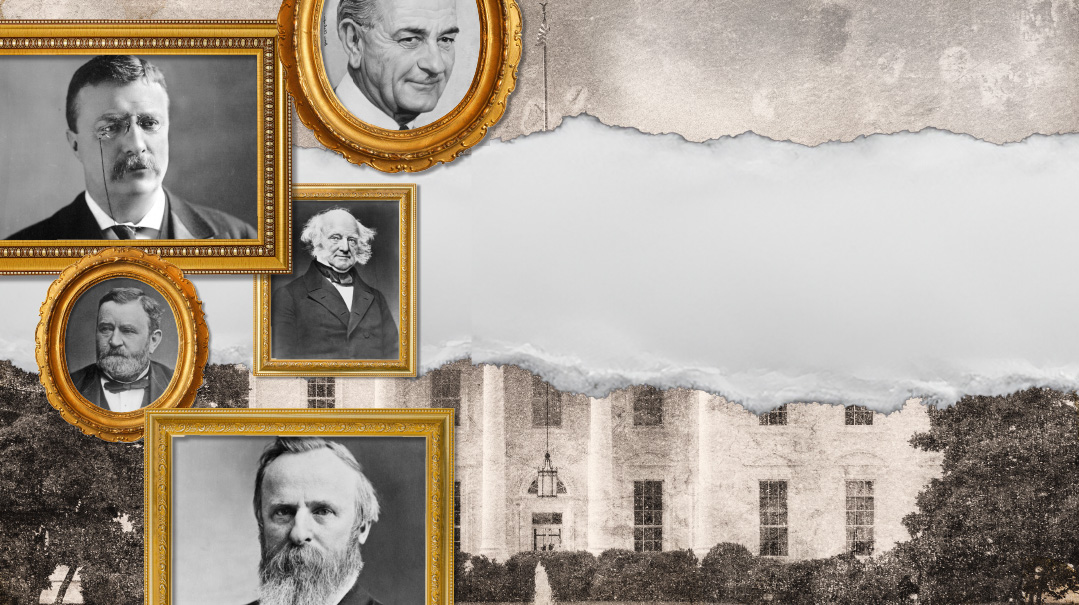Friends in High Places

US presidents and their relationships with American Jews

A monk disappears in Damascus, and the Christians blame the Jewish community. Sixty-three young children are detained until someone “confesses” to the murder, and the Jewish suspects are tortured as the world turns a blind eye. The situation gets progressively worse… until a furious President Martin Van Buren steps in.
A new father decides to name his bechor after his close friend and commanding officer in the Civil War who allowed him to take Pesach off and have a “proper” seder. Even more surprisingly, President Rutherford B. Hayes frequently inquires after “little Ruddy.”
A young Congressman looks over his shoulder to make sure no one is watching, and then works on obtaining immigration papers and smuggling routes through the Port of Galveston, Texas. The year is 1937, and Lyndon B. Johnson is trying to get as many Jews as he can to safe American shores.
As a nation that has influenced American history since its inception, the Jewish community has had both positive and negative interactions with those in power. As the most significant presidential election of our lifetime once again raises the question of, “Which candidate is best for us?” Mishpacha looks back at some of the lesser-known yet still consequential presidential-Jewish relationships.
Martin Van Buren
8th President
Terms served: 1 (1837–1841)
A friend in need: First president to intervene on behalf of Jews abroad
ON February 5th, 1840, the Syrian Jewish community was thrown into peril when Father Thomas, an Italian monk, and his Muslim servant, Ibrahim Amara, disappeared in Damascus. Despite there being no evidence of the Jews’ involvement — in fact, historians think it’s more likely that Father Thomas was murdered by a local Turkish muleteer — the good citizens of Damascus could never lose an opportunity to scapegoat a Jew. Accusations of “blood matzos” spread rapidly (a common justification for many European blood libels), and thus began what became known as the Damascus affair. At the time, the city was governed by the (anti-Semitic) French consul, Ulysse de Ratti-Menton, who ordered a search of the Jewish quarter. While his hunt did not unearth any stored blood or bodies, Ulysse de Ratti-Menton was not about to let a small matter of literally no evidence get in the way of his convictions. A Jewish barber named Solomon Negrin was arbitrarily pulled off the street and tortured until he “confessed” that the monk had been killed in the house of David Harari — a wealthy member of the community — by seven Jews, who were rounded up before they could flee.
Meir Farhi, another wealthy Jew, was indicted in the disappearance of Ibrahim Amara. The Damascus authorities were furious that he escaped before they arrived to arrest him. Determined to drive him out of hiding, they began to whip his toddler son. After being forced to watch her son receive 300 lashes, and nearly bleed to death, a distraught Mrs. Farhi gave the authorities her husband’s location (along with a bribe for “humane” treatment), and he was promptly imprisoned.
In the interim, none of the seven “conspirators” in Father Thomas’s murder confessed, despite being tortured. Wanting a “confession,” as they still didn’t have any physical proof, Damascus authorities abducted 63 Jewish children (along with their mothers) and refused to release them until someone owned up. Aslan Farhi, a brother of Meir Farhi, confessed to the murder under torture.
While the Christians and Muslims had found their “murderers,” they still hadn’t located the bodies or the blood. Investigators eventually found some animal bones in the sewer, and claimed they belonged to Thomas and Amara. A local physician refused to certify that they were human bones and suggested they be forwarded to Europe for confirmation, but the French consul decided that would be too much effort — he had all the proof he needed.
Jewish communities worldwide were horrified about the blood libel, and even more so about the fact that the greater world accepted it as justified. No one in Europe rose to the defense of the Damascus Jewish community, or even questioned the obvious discrepancies in the case. But before the American Jewish community could take action, President Martin Van Buren spoke up.
Though the State Department issued an official statement condemning the situation in Damascus, President Van Buren wasn’t content to just send his “thoughts and prayers,” and instructed his government to pressure and influence the Sultan as well.
The American consul in Constantinople, David Porter, received the following message: “…As the scene of these barbarities are in the Mahomedan dominions, and as such inhuman practices are not of infrequent occurrence in the East, the President has directed me to instruct you do to everything in your power with the Government of his Imperial Highness, the Sultan to whom you are accredited… to prevent or mitigate these horrors…”
Mr. Porter’s pressure campaign (along with some assistance from the British and French governments) forced Pasha Muhammed Ali, the Ottoman Viceroy and ruler of Egypt and Syria, to end the torture and imprisonment of the Jewish prisoners who were still alive. Additionally, the American ambassador (along with Moses Montefiore) was able to secure an Ottoman imperial decree declaring that the blood libel had “not the least foundation in truth,” and that Jews “shall possess the same advantages and enjoy the same privileges” as his other subjects — most notably the free exercise of their religion.
While the American Jewish communities arranged protests in New York, Boston, Charleston, and Philadelphia, these rallies took place two weeks after the President intervened. His actions were a matter of conscience, not the result of political pressure or lobbying.
Oops! We could not locate your form.







